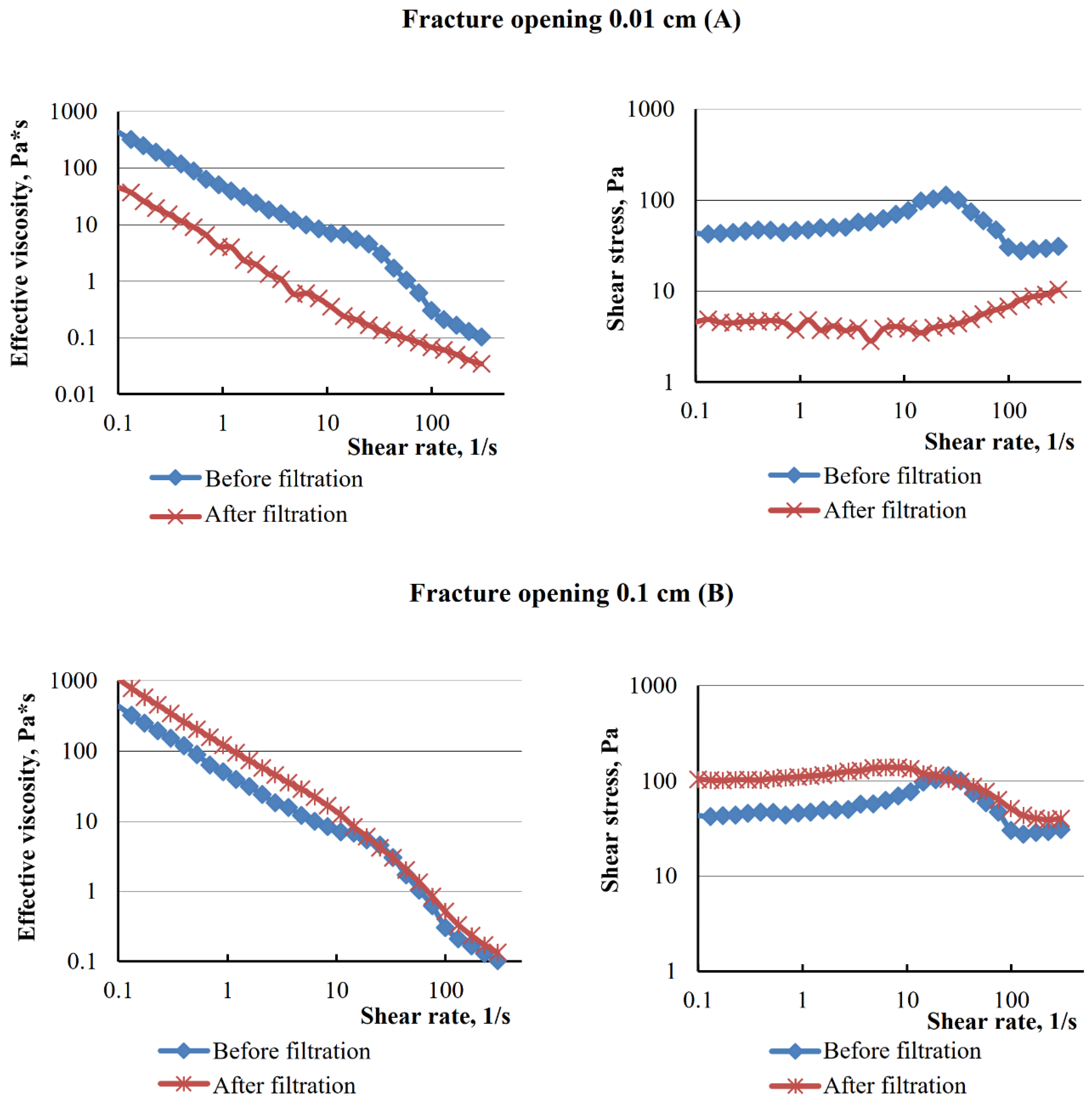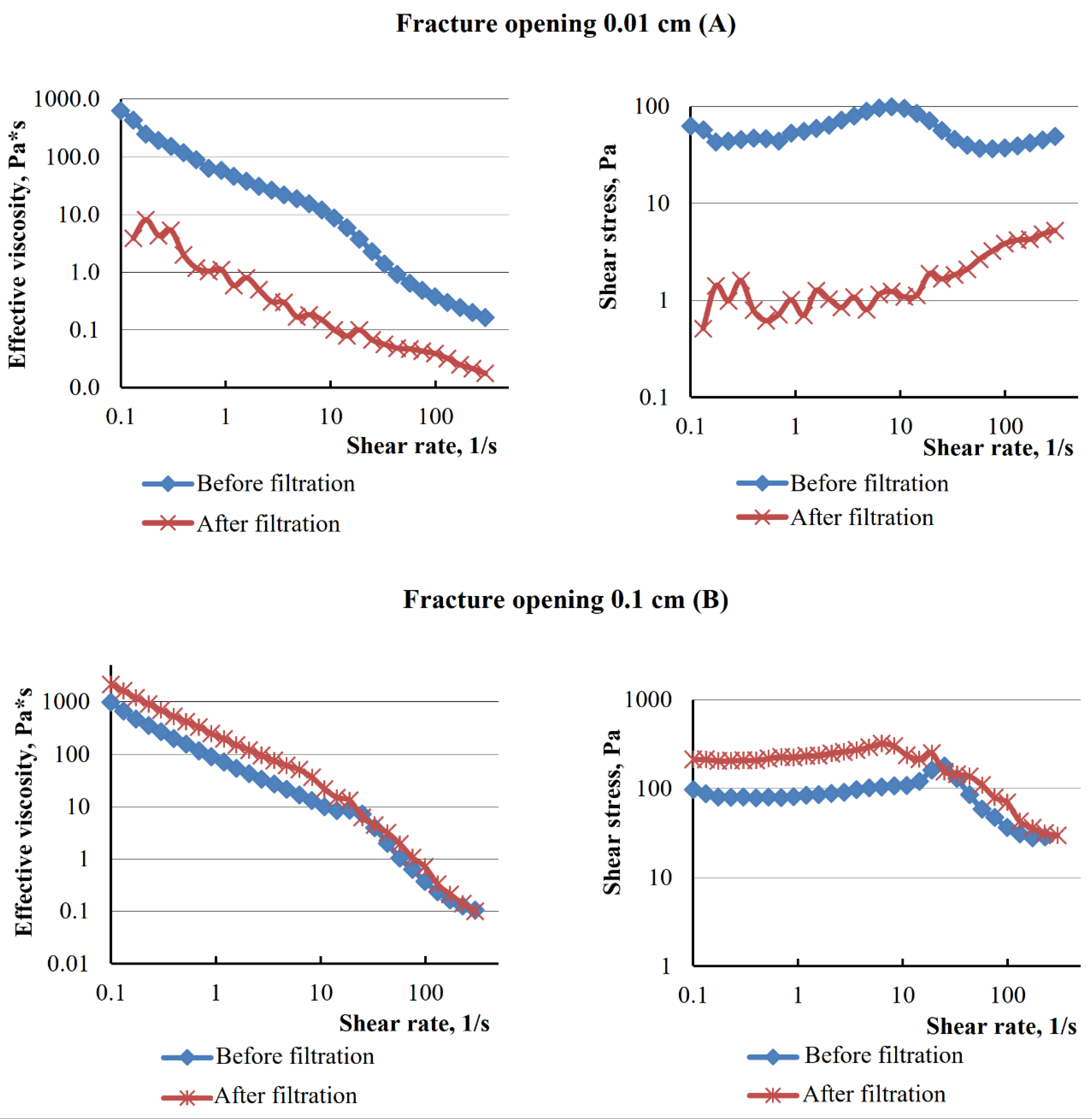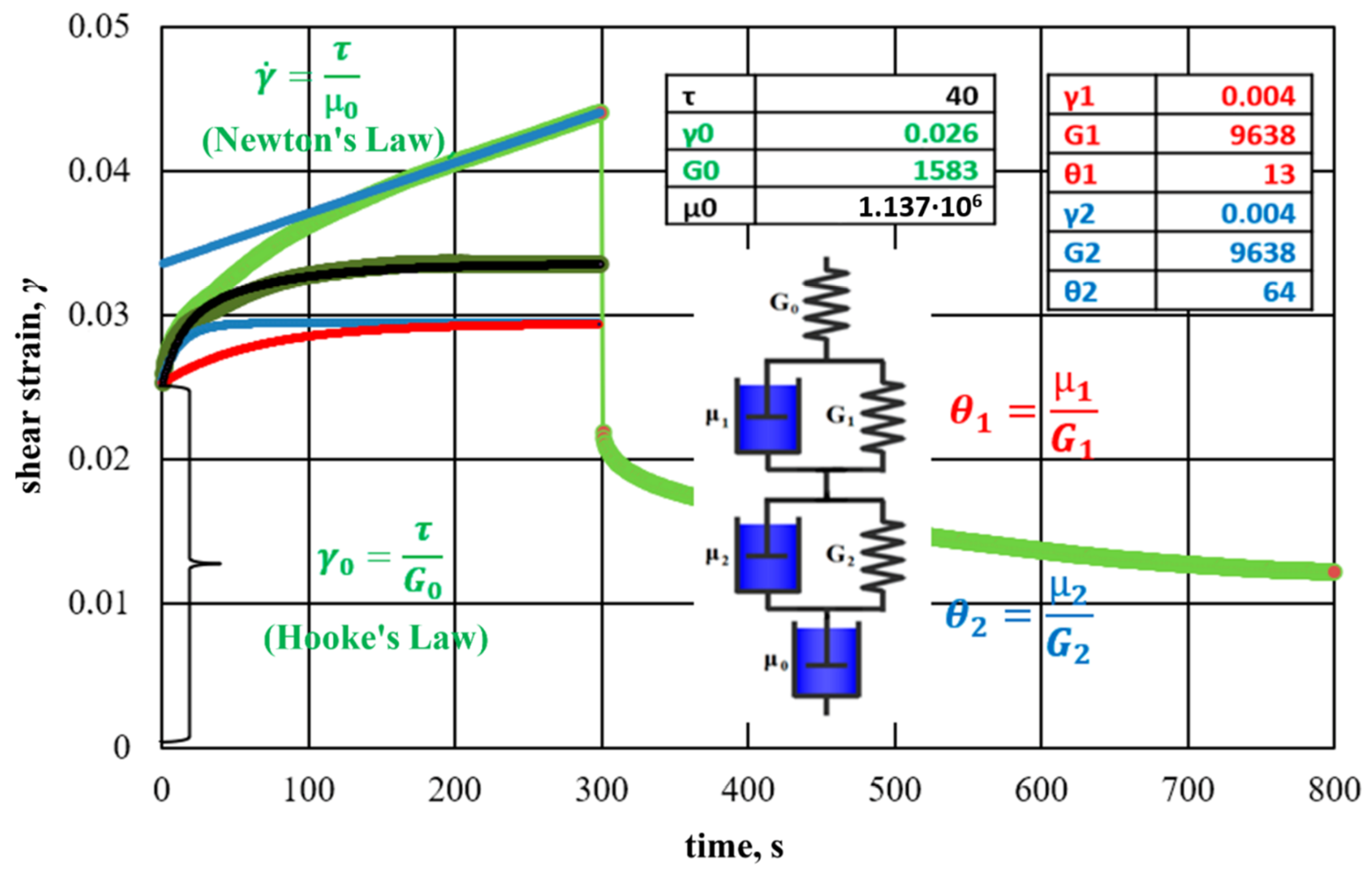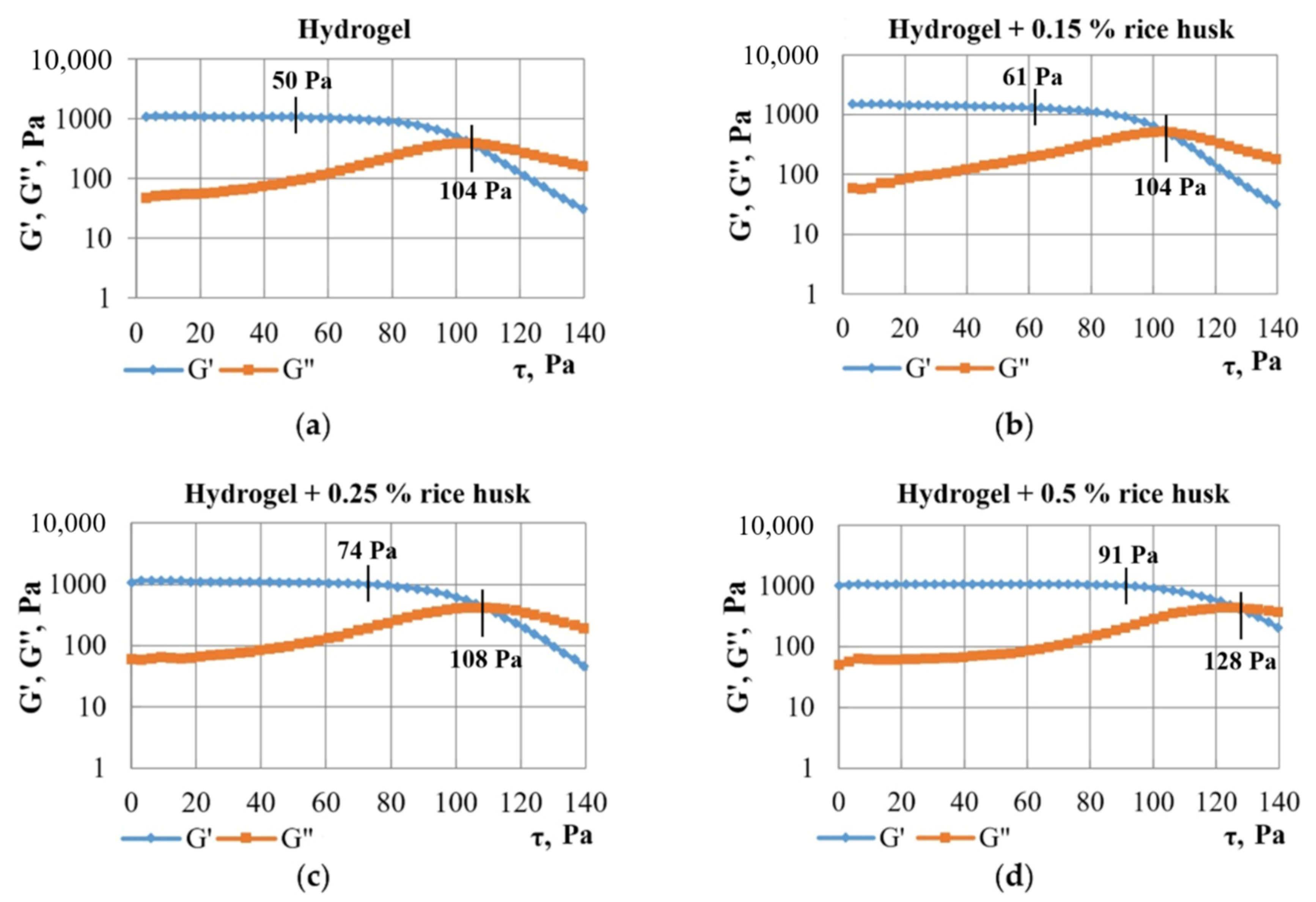Application of Renewable Natural Materials for Gas and Water Shutoff Processes in Oil Wells
Abstract
1. Introduction
2. Materials and Methods
2.1. Methodology of Rheological Experiments
2.2. Filtration Testing Methods
- Linear length of the core model: from 100 to 300 mm;
- Core temperature control range: from +25 to +150 °C;
- Maximum rock pressure: 70 MPa;
- Maximum reservoir pressure: 55 MPa.
3. Results and Discussion
3.1. Development of a Mechanochemical Activation Method for Processing Natural Materials to Obtain Water-Sealing Compositions
3.2. Study of the Stability of Sodium Silicate-Based Hydrogels with Additives from Mechanically Activated Rice Husk during Fracture Filtration
3.3. Oscillatory Rheometry of Hybrid Hydrogels
4. Conclusions
Author Contributions
Funding
Data Availability Statement
Conflicts of Interest
References
- Meshalkin, V.P.; Dovì, V.G.; Bobkov, V.I.; Belyakov, A.V.; Butusov, O.B.; Garabadzhiu, A.V.; Burukhina, T.F.; Khodchenko, S.M. State of the art and research development prospects of energy and resource-efficient environmentally safe chemical process systems engineering. Mendeleev Commun. 2021, 31, 593–604. [Google Scholar] [CrossRef]
- Baykova, E.N.; Muslimov, R.K. Experience in the Application of Water Shut-off and Remedial Cementing Technologies in Fractured Carbonate Reservoirs. Georesursy Georesources 2016, 18, 175–185. [Google Scholar] [CrossRef]
- Presnyakov, A.Y.; Lomakina, I.Y.; Nigmatullin, T.E.; Razyapov, R.K.; Sorokin, A.S. An integrated approach to the selection of technologies for controlling water and gas inflow under the conditions of Yurubcheno-Tokhomskoye field. Neftyanoe khozyaystvo Oil Ind. 2014, 6, 94–98. [Google Scholar]
- Zemtsov, Y.V. Development and Improvement of Repair and Insulation Works at the Fields of Western Siberia; Nedra LLC: St. Petersburg, Russia, 2014; 320p. [Google Scholar]
- Strizhnev, K.V. Repair and Insulation Work in Wells: Theory and Practice; Nedra LLC: St. Petersburg, Russia, 2010; 560p. [Google Scholar]
- Seright, R.; Brattekas, B. Water shutoff and conformance improvement: An introduction. Pet. Sci. 2021, 18, 450–478. [Google Scholar] [CrossRef]
- Safarov, F.E.; Gusarova, I.I.; Karazeev, D.S.; Arslanov, I.R.; Telin, A.G.; Dokichev, V.A. Synthesis of Polyacrylamide Gels for Restricting the Water Inflow in Development of Oil Fields. J. Appl. Chem. 2018, 91, 755–759. [Google Scholar] [CrossRef]
- Lei, S.; Sun, J.; Lv, K.; Zhang, Q.; Yang, J. Types and Performances of Polymer Gels for Oil-Gas Drilling and Production: A Review. Gels 2022, 8, 386. [Google Scholar] [CrossRef] [PubMed]
- Guo, P.; Tian, Z.; Zhou, R.; Chen, F.; Du, J.; Wang, Z.; Hu, S. Chemical Water Shutoff Agents and Their Plugging Mechanism for Gas Reservoirs: A Review and Prospects. J. Nat. Gas Sci. Eng. 2022, 104, 104658. [Google Scholar] [CrossRef]
- Baranov, Y.V.; Nigmatullin, I.G.; Nizamov, R.K.; Mardanov, A.F.; Shpurov, I.V.; Ramazanov, R.G.; Kasimov, R.S. Application of technology based on wood flour for enhanced oil recovery and isolation of water inflow. Oil Ind. 1998, 7, 24–28. [Google Scholar]
- Fattakhov, I.G.; Kadyrov, R.R.; Glushko, A.S. Isolation of water inflows in wells through the use of gel-forming compositions. Mod. Probl. Sci. Educ. 2015, 6, 331–335. [Google Scholar]
- Gubaidullin, F.A.; Kashaev, R.A. Cellulose Flour for Shutoff of Water-Bearing or Watered Layers in Order to Increase Production Rate and Method for Its Manufacturing. Patent RU2575488C2, 20 February 2016. [Google Scholar]
- Sultanov, I.K.; Sagidullin, I.A.; Blinov, S.A. Isolation Method of Water Influx in Well. Russian Patent RU2476665C2, 27 February 2013. [Google Scholar]
- Shakhverdiev, A.K.; Panakhov, G.M.; Sharifullin, F.A. Method of Selective Isolation of High-Permeability Formation Intervals in Well. Russian Patent RU2183727C1, 6 June 2002. [Google Scholar]
- Matveev, S.; Gazizov, A.; Gazizov, A. Polymer Dispersed Systems for Conformance Improvement in Fractured Carbonate Reservoirs. In Proceedings of the Abu Dhabi International Petroleum Exhibition & Conference, Abu Dhabi, United Arab Emirates, 9–12 November 2020. [Google Scholar]
- Odeh, N.M.M.; Chaabouni, H.; Chan, K.S.; Enkababian, P. Tight Formation Water Shut off Method with Silica Gel. U.S. Patent US7458424B2, 2 December 2008. [Google Scholar]
- Huang, T.; Xu, R. Method of Isolating and Completing Multiple Zones within a Wellbore. U.S. Patent US9004169B2, 14 April 2015. [Google Scholar]
- Gafarov, S.A.; Gafarov, N.A.; Tryupina, V.M.; Khasanov, F.F.; Ten, A.V. Water Shutoff Composition. Russian Patent RU2215135C1, 27 October 2003. [Google Scholar]
- Zhirkeev, A.S.; Sakhapova, A.K.; Khasanova, D.K. Method for repair and insulation works in well. Russian Patent RU2601888C1, 10 November 2016. [Google Scholar]
- Malkin, A.Y.; Isaev, A.I. Rheology: Concepts, Methods, Applications; Planeta: St. Petersburg, Russia, 2010; p. 557. [Google Scholar]
- Fuchsman, C.H. Peat: Industrial Chemistry and Technology; Academic Press: Cambridge, MA, USA, 1980; 298p. [Google Scholar]
- Baramboim, N.K. Mechanochemistry of High-Molecular Compounds; Khimiya: Moscow, Russia, 1978; p. 384. [Google Scholar]
- Khodakov, G.S. Physics of Grinding; Nauka: Moscow, Russia, 1972; p. 307. [Google Scholar]
- Koopal, L.K.; Yang, Y.; Minnaard, A.J.; Theunissen, P.L.M.; Van Riemsdijk, W.H. Chemical immobilisation of humic acid on silica. Colloids Surf. A Physicochem. Eng. Asp. 1998, 141, 385–395. [Google Scholar] [CrossRef]
- Politov, A.A.; Ilash, D.A.; Lenchankova, L.E.; Telin, A.G.; Akhmetov, A.T. Study of initial gelation of hybrid materials comprising synthetic and natural polymers. Mater. Today Proc. 2020, 25, 487–489. [Google Scholar] [CrossRef]
- Elhaei, R.; Kharrat, R.; Madani, M. Stability, Flocculation, and Rheological Behavior of Silica Suspension-Augmented Polyacrylamide and the Possibility to Improve Polymer Flooding Functionality. J. Mol. Liq. 2021, 322, 114572. [Google Scholar] [CrossRef]
- Strizhnev, V.A.; Arslanov, I.R.; Ratner, A.A.; Fahreeva, A.V.; Politov, A.A.; Lenchenkova, L.E.; Zhuravlev, A.S.; Telin, A.G. Development of new grouting compositions for insulation work in wells of fractured reservoirs. Oil. Gas. Innov. 2021, 3, 26–31. [Google Scholar]
- Díez-Pascual, A.M. Nanoparticle Reinforced Polymers. Polymers 2019, 11, 625. [Google Scholar] [CrossRef] [PubMed]
- Asai, F.; Seki, T.; Hoshino, T.; Liang, X.; Nakajima, K.; Takeoka, Y. Silica Nanoparticle Reinforced Composites as Transparent Elastomeric Damping Materials. ACS Appl. Nano Mater. 2021, 4, 4140–4152. [Google Scholar] [CrossRef]
- Politov, A.; Golyazimova, O. Increasing the energy yield of mechanochemical transformations: Selected case studies. Faraday Discuss. 2014, 170, 345–356. [Google Scholar] [CrossRef] [PubMed]
- Klasing, K.C. Avian Gastrointestinal Anatomy and Physiology. Semin. Avian Exot. Pet Med. 1999, 8, 42–50. [Google Scholar] [CrossRef]
- Meshalkin, V.P.; Yakubov, R.N.; Lenchenkova, L.E.; Chelnokov, V.V. Computer-aided simulation of the combined chemical-technological process of water shutoff in porous watered oil reservoirs. Rep. Russ. Acad. Sci. Chem. Mater. Sci. 2021, 501, 37–42. [Google Scholar] [CrossRef]








| Raw Materials | Grinding Technology | |
|---|---|---|
| Mechanochemical | Mechanoenzymatic | |
| Fractions, Proportion Less than 50 μm, wt. % | ||
| Sawdust | 11 | 48 |
| Rice husk | 15 | 87 |
Publisher’s Note: MDPI stays neutral with regard to jurisdictional claims in published maps and institutional affiliations. |
© 2022 by the authors. Licensee MDPI, Basel, Switzerland. This article is an open access article distributed under the terms and conditions of the Creative Commons Attribution (CC BY) license (https://creativecommons.org/licenses/by/4.0/).
Share and Cite
Meshalkin, V.; Akhmetov, A.; Lenchenkova, L.; Nzioka, A.; Politov, A.; Strizhnev, V.; Telin, A.; Fakhreeva, A. Application of Renewable Natural Materials for Gas and Water Shutoff Processes in Oil Wells. Energies 2022, 15, 9216. https://doi.org/10.3390/en15239216
Meshalkin V, Akhmetov A, Lenchenkova L, Nzioka A, Politov A, Strizhnev V, Telin A, Fakhreeva A. Application of Renewable Natural Materials for Gas and Water Shutoff Processes in Oil Wells. Energies. 2022; 15(23):9216. https://doi.org/10.3390/en15239216
Chicago/Turabian StyleMeshalkin, Valery, Alfir Akhmetov, Lyubov Lenchenkova, Antony Nzioka, Anatoly Politov, Vladimir Strizhnev, Aleksey Telin, and Alsu Fakhreeva. 2022. "Application of Renewable Natural Materials for Gas and Water Shutoff Processes in Oil Wells" Energies 15, no. 23: 9216. https://doi.org/10.3390/en15239216
APA StyleMeshalkin, V., Akhmetov, A., Lenchenkova, L., Nzioka, A., Politov, A., Strizhnev, V., Telin, A., & Fakhreeva, A. (2022). Application of Renewable Natural Materials for Gas and Water Shutoff Processes in Oil Wells. Energies, 15(23), 9216. https://doi.org/10.3390/en15239216








